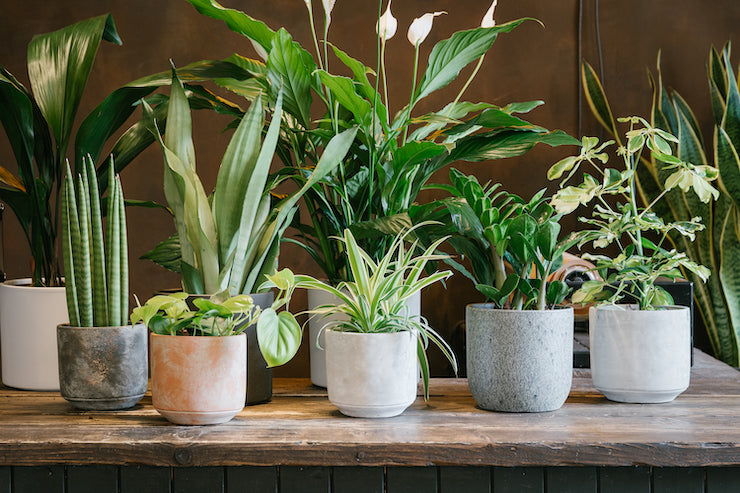
Care Guide: Alocasia
Alocasias are part of the Araceae family and come in so many fabulous forms. From the huge, dark leaves of the Alocasia ‘Regal Shields’ to varieties for smaller spaces, including Alocasia ‘Tiny Dancer’, there are many options to choose from! Commonly known as Elephant Ears or Taro, these plants are a firm favourite with our Plant Gurus as they add instant jungle vibes to any indoor space.
Alocasias are native to the subtropical environments of Eastern Australia and Asia. Like most plants that grow under the tree canopy, these fantastic plants have adapted to grow broad leaves to allow them to soak up as much sunlight as possible in somewhat shadier spots. Larger versions can grow as tall as 10 feet in height to allow for maximum sun-bathing.
Elephant Ears are known for their distinctive leaf shapes and patterns, but beneath the surface of the compost they hide their tuberous rhizomes. These rhizomes are designed to store excess water and nutrients. If you are hoping to expand your collection, tubers can be found within their compost which can be removed and potted up to grow your own baby Alocasias. Alternatively, if you notice your Alocasia consists of several plants these can be divided and potted up separately.
Did you know that Alocasia can produce a reddish-orange fruit? Insignificant blooms are often hidden beneath their huge leaves, but under the right conditions these flowers can turn into fruits!
General Care for Alocasia Plants
Alocasia should be positioned in bright, indirect light. They can withstand a couple of hours of direct sunlight in the morning, however too much direct light can result in scorched leaves. These plants will thrive in a warm spot and should be kept away from draughts or particularly cold spots such as external doors or windows. Elephant Ears are native to humid environments and they benefit from misting of their leaves. Humidity can also be increased by placing the plant on a pebble tray.
Watering requirements can vary depending on the climate of the country you live in. In the UK, due to unpredictable light levels and fluctuating temperatures, Alocasias are more prone to over watering. For this reason, allow at least the top half of compost to dry out completely before adding any water. This can be checked by sticking your finger into the soil to check and also by gauging the weight of the potted plant - the lighter the plant the more the compost will have dried out. In spring and summer, feed twice a month using a high quality liquid houseplant feed. Our favourite feed is Liquid Gold Leaf, which is versatile enough to be used across your plant collection including general houseplants, cacti, succulents and even with hydroponically grown plants.
During the autumn and winter months, Alocasias go dormant and will produce very little to no new growth. Continue caring for your plant as usual, but bear in mind cooler temperatures will result in the compost retaining more moisture and therefore should be watered less frequently. Do not fertilise in the cooler months.
Alocasia plants thrive in free draining compost. Whilst you can get away with using a general houseplant compost for most foliage plants, it is worth creating a specific mix for Alocasias. Blending 60% Soil Ninja base mix with 20% fine bark and 20% vermiculite will add drainage and increase aeration throughout the compost. This will promote healthy root growth and decrease the chance of over-watering.
Tips and Tricks: Caring for Alocasia in the UK
Here in the UK many of our most recognisable houseplants are tropical, which means there are a couple of uniquely British weather factors that we need to keep in mind when caring for Alocasia plants.
- Firstly - do not cut off any damaged leaves. In Britain, Alocasias tend to shed a leaf every time a new leaf begins to grow. We know how tempting it is to remove imperfections, however this could result in a plant with only one leaf! In spring and summer these plants are relatively fast growers so never fear these “ugly” leaves are likely to shed quickly. If the leaves of your plant look like they are beyond saving check the rhizomes in the compost are still firm, cut back all the leaves and store the rhizome(s) in a cool, dry place until spring. This can then be potted up in an Alocasia specific compost mix, then watch as your plant begins to regrow.
- Secondly - water sparingly! Alocasias store a huge amount of water in their stems and rhizomes and, for this reason, it is best to err on the side of under-watering than over-watering. If you notice leaves turning yellow this is usually either a result of overwatering or that your plant is in a particularly draughty spot.
- Finally, rotate your plant occasionally. This will encourage more even growth around the plant and will prevent the Alocasia from becoming too top heavy.
Check out our website or visit us in store to peruse our selection of Alocasias.



